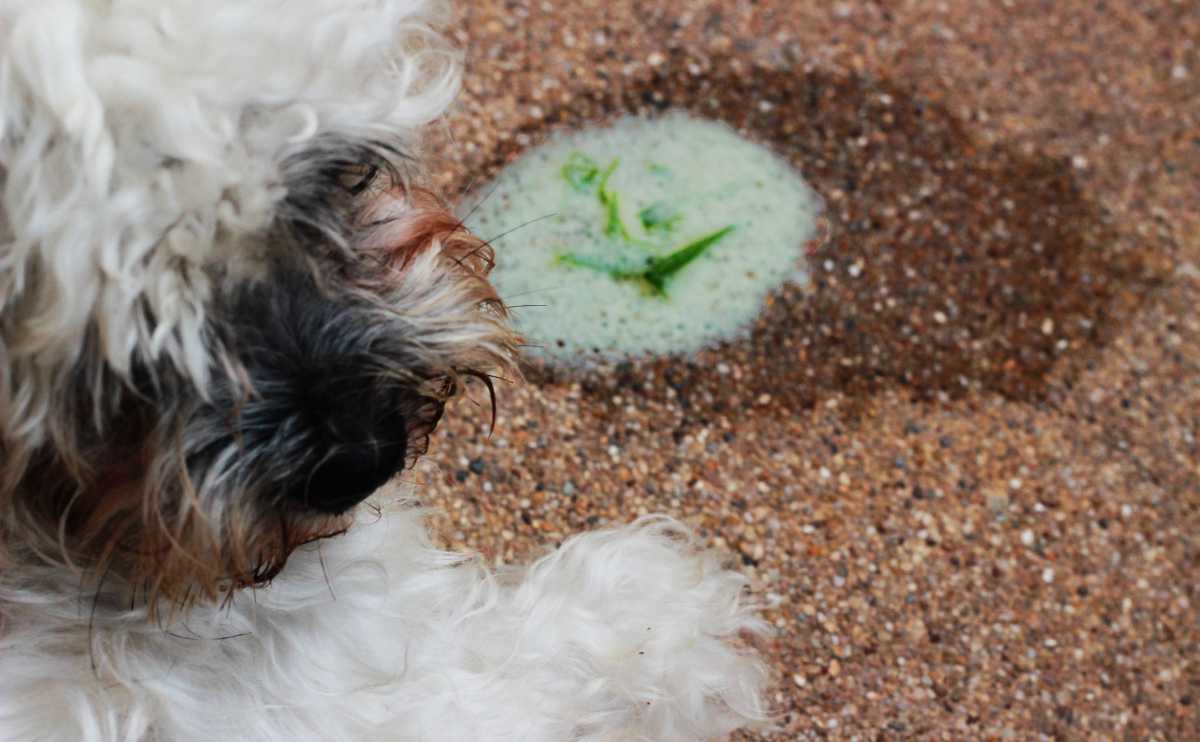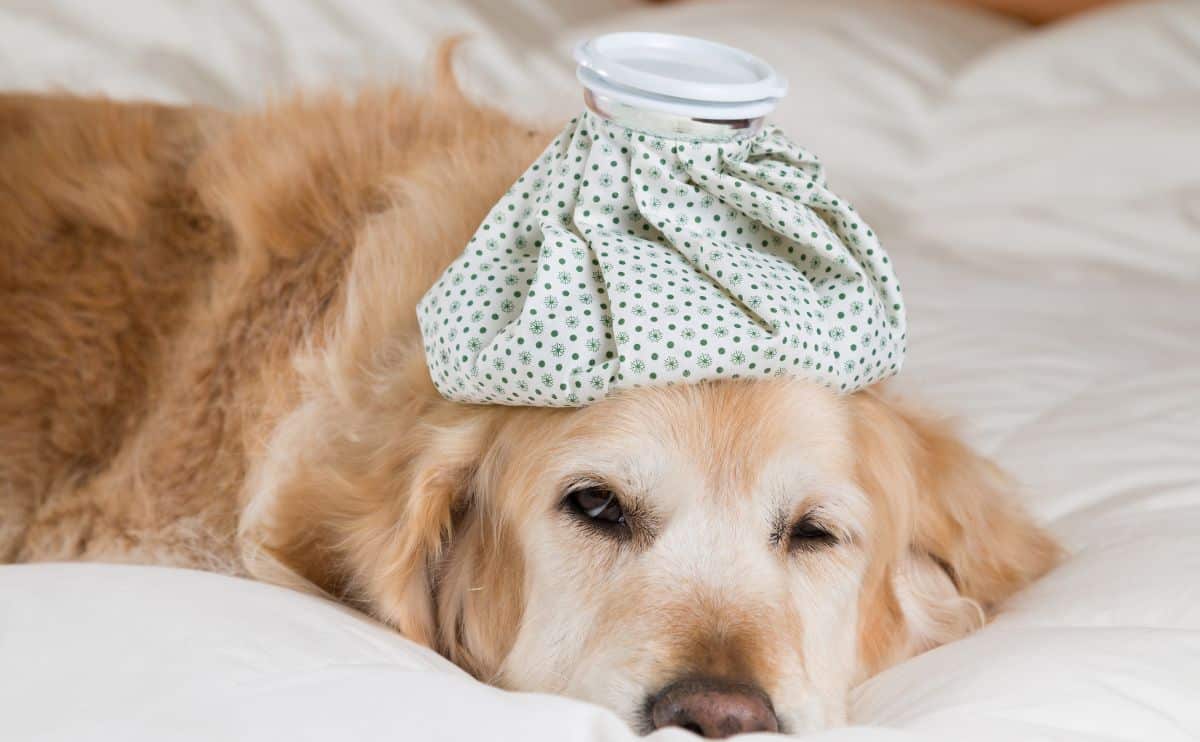Dog Not Pooping? Try These 12 Home Remedies For Dog Constipation That Actually Work
When you purchase through links on our site, we may earn a commission. Here’s how it works.
Your dog hasn’t pooped in days, and now they’re pacing, straining, or even crying out in discomfort. It’s not just heartbreaking… it could become dangerous.
Table of Contents
If Fido’s digestive system has come to a standstill, you’re not alone; many dog owners face this uncomfortable problem at least once. The good news: minor constipation can often be eased at home. But knowing which remedy to try first, how much is safe, and when it’s time to see a veterinarian is key.
Constipation in dogs is very common. At some point during any dog’s life, they’ll likely experience it at least once. Both of my dogs have. In most cases, it’s a temporary disturbance that passes within a day or two.
So, if you’re wondering, “How do I treat dog constipation at home?” or “What can I give my dog for constipation?” you’ve come to the right place. I explore 12 home remedies for dog constipation, the best natural laxatives for dogs, and when to see a vet. So, let’s see if I can help you boot the scoot at home.

What Is Dog Constipation?
Constipation in dogs occurs when they have trouble passing stool or their poop is particularly dry or hard. It’s pretty common, but just like when we are constipated, it is uncomfortable and often painful. Dog constipation can cause stress and further health conditions, such as anal gland problems, rectal prolapse, other disorders of the rectum, and colitis, most of which require veterinary treatment.
Symptoms Of Dog Constipation
There are many symptoms of constipation in dogs, including:
- Straining to poop
- Whimpering
- Vomiting
- Decreased appetite
- Circling and squatting more frequently than normal
- Scooting
- Small, hard stools that resemble pebbles
- Small amounts of watery feces (sometimes containing mucus)
We have a guide on dog constipation that provides more information on the causes, veterinary treatment, prevention, and more.
When To See A Vet For Dog Constipation
If you’re wondering when dog constipation is an emergency, you are not alone. Although dog constipation usually passes with home remedies and natural laxatives, your dog might need treatment from a vet. Before I get into how to treat dog constipation at home, it’s essential to know when you need to see a vet.
- Your dog hasn’t pooped in 48 hours
- Appears to be in a lot of pain
- Abnormally lethargic
- Has a swollen abdomen
- Is vomiting
- There’s blood in their stools
- If you suspect they’ve swallowed a foreign object
Watch this quick video where Dr. Greer, DVM, explains how to help a constipated dog and why seeking medical attention is essential if it doesn’t resolve quickly.
Dog Constipation vs Blockage
It can be challenging to know if your dog has just constipation or if they have an internal blockage that is causing their constipation.
- Bowel obstructions in dogs are dangerous and can be fatal within days without veterinary treatment.
- A foreign object, a tumor, or a rupture could cause an obstruction.
This is why it is imperative to take your dog to the vet if they haven’t pooped in two days or notice or suspect any of the above symptoms. Blockages are an emergency. So, if you’re in doubt whether it’s constipation or a blockage, please see your vet.
12 Effective Home Remedies for Dog Constipation
If your dog is blocked up and you’re wondering what you can give your dog for constipation, there are a few home remedies you can try. These remedies range from things dogs can eat for constipation to things you can do to help promote regular bowel movements.
1. Increase Water Intake
The most common reason dogs are constipated is dehydration. It’s important to ensure your dog has access to clean, fresh water at all times. If they aren’t drinking enough, add a little water to their food bowl to increase their water intake.

Many dog owners find that using a dog water fountain, with the sound of trickling water, encourages dogs to drink more.
- Why it helps: Dehydration is a leading cause of constipation in dogs.
- How to use it: Ensure constant access to clean, fresh water; add water to food if needed.
- Tip: Try a dog water fountain—flowing water often encourages dogs to drink more.
- Bonus: Wet foods and broths can also boost moisture intake.
Safe Use & Vet Warning:
Always provide unlimited access to clean, fresh water. If your dog isn’t drinking enough, add 1–2 tablespoons of warm water or low-sodium broth to meals.
- Avoid if: Your dog is vomiting, lethargic, or refusing all food and water — these are signs of a more serious issue.
- Stop & call your vet if: Your dog still hasn’t pooped after 48 hours, or is showing signs of bloating or discomfort.
Note: This is a supportive measure, not a substitute for veterinary care, for moderate to severe constipation.
2. Regular Exercise
Just as dehydration is a common cause of dog constipation, so is a lack of exercise. Exercise helps to move things about, stimulate their metabolism, and regulate blood flow, which is why dogs often poop on their walks. If it’s safe, increase their activities to help get things moving again.

A lack of exercise during recovery from surgery is one of the main reasons why pups become constipated. A dog lift harness can sometimes help with exercise during recovery.
- Why it helps: Physical activity stimulates digestion and bowel movements.
- How to use it: Take your dog for frequent walks, play fetch, or increase indoor activity.
- Recovery tip: After surgery, use a dog lift harness to support gentle movement.
- Extra: Even short, frequent walks can relieve mild constipation.
Safe Use & Vet Warning:
Light to moderate exercise (e.g., 10–15 min walk) is generally safe for healthy dogs. Do not force movement in injured or post-surgical dogs without vet clearance.
- Avoid if: Your dog has mobility issues, heart problems, or is recovering from surgery without vet approval.
- Stop & call your vet if: Exercise causes collapse, heavy panting, pain, or worsens symptoms.
Note: Exercise helps stimulate digestion but won’t resolve constipation caused by obstructions or systemic illness.
3. Canned Dog Food
My young Doxie is prone to constipation, which our vet said is likely due to her being a small breed. When she is not regular, I increase her wet food intake to boost moisture and reduce the amount of kibble in her bowl.

This usually is enough to help loosen things up. We have a guide on the best wet dog food to add to their diet to help them be more regular.
- Why it helps: Wet food increases dietary moisture and softens stools.
- How to use it: Replace some or all dry kibble with canned food temporarily.
- Vet tip: Especially useful for small breeds prone to GI issues.
Safe Use & Vet Warning:
Substitute 25–50% of dry food with canned food to increase moisture. Monitor for improved stool over 24–48 hours.
- Avoid if: Your dog has food sensitivities, pancreatitis, or needs a prescription diet. Always check with your vet.
- Stop & call your vet if: Diarrhea develops, vomiting begins, or your dog refuses to eat the wet food.
Note: Canned food can ease mild constipation, but persistent symptoms require professional evaluation.
4. High-Fiber Dog Food
Dietary fiber is one of the most substantiated nutritional interventions for canine constipation and GI health. Studies show that dogs with conditions predisposing to constipation (spinal disease, perineal hernia, etc.) fed 2% psyllium had improved stool consistency in over 60 % of cases.
As non-soluble fiber moves through the gut, it speeds up gut motility. Picking a high-fiber diet can help regulate the GI tract and promote healthier stools.

A high-fiber diet is any diet with a fiber value of 6% or more. You can find the fiber value on the guaranteed analysis label on most packaging. We have picked our favorite high-fiber dog diets to make choosing one easier. Remember to speak to your vet before changing your dog’s diet for a medical issue.
- Why it helps: Insoluble fiber speeds up stool movement through the gut.
- How to use it: Choose foods with at least 6% fiber (check the guaranteed analysis).
- Vet advice: Always consult your vet before switching foods for medical reasons.
Proper hydration is key. Remember, when increasing fiber intake, ensure water intake keeps pace, or the added fiber may worsen constipation. The dog’s gut microbiome plays a pivotal role: fiber, probiotics, and even exercise together influence motility, bacterial balance, and colon health.
Safe Use & Vet Warning:
Transition slowly over 5–7 days to avoid GI upset.
- Avoid if: Your dog has IBD, pancreatitis, or is underweight — high fiber may not be appropriate.
- Stop & call your vet if: Constipation worsens, diarrhea starts, or your dog refuses the new food.
Note: Always consult your vet before switching to a high-fiber diet for medical reasons.
5. Pumpkin Puree
Giving your dog pumpkin puree is a commonly used natural remedy for constipation in dogs. Pumpkin is a prebiotic fiber that promotes good gut bacteria and stimulates intestinal water absorption. This natural ingredient is gentle on the digestive system, and thankfully, most dogs love it.
Pumpkin’s soluble fiber helps absorb water and bulk up stools, making them easier to pass. It works as both a prebiotic (feeding beneficial gut bacteria) and a mild bulking agent. The Merck Veterinary Manual supports adding 1–4 tablespoons of plain pumpkin to meals during mild constipation, provided hydration is adequate.

Cans of pumpkin puree are readily available in grocery stores. Just be sure to buy 100% pumpkin puree, not pumpkin pie filling. Pie filling contains ingredients that might upset their tummy further, such as spices, sugar, and fats.
- Why it helps: A natural prebiotic fiber that supports healthy gut bacteria.
- How to use it: Add 1–2 tablespoons to meals (adjust based on your dog’s size).
- Important: Use only 100% pumpkin puree. Avoid pie filling with sugar and spices.
- Real-life tip: Works well for picky or older dogs who resist other fiber sources.
Safe Use & Vet Warning:
Use 1 tsp per 10 lbs of body weight, up to 2x per day. Only use plain 100% pumpkin puree.
- Avoid if: Your dog has diabetes (due to sugar content) or is prone to loose stools.
- Stop & call your vet if: Diarrhea develops, or constipation continues for more than 48 hours.
Note: Pumpkin is a gentle remedy but should not be relied on daily without vet guidance.
Mini Success Story Using Pumpkin Puree For Dog Constipation
My senior dog, Daisy, sometimes gets constipation due to her lower activity level. Due to mobility issues, she cannot get out as much and is not as active as she used to be. She is also fussy with her food, and these two things can lead to constipation.
After seeing her straining, I spoke with our vet, who suggested trying some plain pumpkin puree with her food. This has proven very effective for her, helping things move along in about a day or so. I add a few tablespoons, about two or three, to her food at mealtimes when she is constipated and at least one tablespoon for her daily meals.
Doing this helps her bowels stay healthy due to the fiber, adding extra flavor and moisture to her food, which she likes. It also has dramatically reduced the times she has to strain to poop. Plus, pumpkin puree is inexpensive and easy to find. It is much easier for her to eat and tastes a lot better than taking medication.
– Danielle DeGroot, Rescue Dog Parent, Canine Journal Research & Writing
6. Dog-Safe Vegetables
Giving Fido a dog-safe vegetable can help push things through and ease constipation. Broccoli, carrots, celery, and zucchini are high in fiber and can help regulate their digestive system.

Most dogs love crunchy snacks, and carrots are a big hit with my pups. Plus, these treats are low in calories and a healthy snack.
- Why it helps: Crunchy veggies like carrots, broccoli, and zucchini add fiber.
- How to use it: Offer raw or lightly steamed as snacks or meal toppers.
- Warning: Avoid toxic foods (like onions and garlic). Always check safe food lists.
- Tip: Carrots are low-calorie and usually well accepted by dogs.
Safe Use & Vet Warning:
Start with 1–2 tbsp of chopped raw or lightly steamed veggies.
- Avoid if: Your dog has a history of gas, bloating, or food allergies.
- Stop & call your vet if: Digestive upset, vomiting, or excessive flatulence occurs.
Note: Always check which fruits and vegetables are safe for dogs before feeding.
7. Yogurt
Yogurt with probiotic strains of live and active cultures can help ease your dog’s constipation. Not all yogurt contains probiotics, so it’s essential to check the label and make sure it is natural, not sweetened or flavored.

A tablespoon of plain natural or Greek yogurt on top of your dog’s daily food can help restore a healthy bacterial balance within the gut and boost their immune system.
- Why it helps: Natural source of probiotics to support gut health.
- How to use it: Add 1 tablespoon of plain or Greek yogurt to food daily.
- Warning: Avoid flavored or sweetened yogurt; use unsweetened with live cultures.
- Extra: May also support immune system function.
Safe Use & Vet Warning:
Use 1 tbsp of plain, unsweetened yogurt per 25 lbs of body weight. Choose varieties with live probiotics.
- Avoid if: Your dog is lactose intolerant, has dairy allergies, or has chronic pancreatitis.
- Stop & call your vet if: Loose stools or vomiting occur after yogurt is introduced.
Note: Yogurt is not a substitute for veterinary probiotics in dogs with chronic GI issues.
8. Bone Broth
Adding bone broth to your dog’s food is not only super tasty but can also help soften hard stools, thanks to the moisture. Brutus Bone Broth is a popular and convenient option to pour or mix into their food. It also has lots of other health benefits.

If you find your dog isn’t drinking water, you can give this to them as a drink, which can help loosen things up.
- Why it helps: Adds hydration and nutrients while softening stools.
- How to use it: Pour over kibble or serve separately as a warm drink.
- Warning: Choose low-sodium broths made specifically for dogs.
Safe Use & Vet Warning:
Add 2–4 tbsp of unsalted, low-fat bone broth to meals or offer as a warm drink.
- Avoid if: The broth contains onions, garlic, salt, or additives — these can be toxic.
- Stop & call your vet if: Your dog vomits, develops diarrhea, or refuses food after consuming broth.
Note: Use only dog-safe bone broths. Avoid store-bought broths unless labeled pet-safe.
9. Dietary Fiber Supplements
A lack of fiber is one of the most common causes of dog constipation. Adding dietary fiber supplements such as PetHonesty’s High Fiber Pumpkin Flavored Powder Digestive Aid is a convenient way to add fiber to their diet.

It also contains psyllium seed husk powder, a natural laxative that helps with regularity. Following the feeding guidelines is essential, as too much fiber can cause diarrhea.
Because psyllium is a soluble fiber, it ferments in the colon and produces short-chain fatty acids that help support gut motility and colon health.
- Why it helps: Convenient way to increase fiber for stool regularity.
- How to use it: Follow label instructions and adjust for dog size.
- Warning: Too much fiber can cause diarrhea—start with the lower dose.
Several studies confirm that supplementing a dog’s diet with psyllium (2–4 %) can increase stool moisture and make defecation easier. In one trial of 24 constipated dogs, 62.5% of owners reported that their dog’s stools changed from dry/hard to pasty or normal.
Safe Use & Vet Warning:
Follow the product’s label for dosing based on weight. Introduce slowly and mix well into food.
- Avoid if: Your dog has IBS, diarrhea-prone digestion, or is already on other fiber sources.
- Stop & call your vet if: Loose stools, bloating, or vomiting occur after adding fiber.
Note: High-fiber supplements should only be used long-term with veterinary oversight.
10. Probiotics
Adding probiotics to your dog’s mealtime can help regulate your dog’s digestive tract and help them produce healthier stools. Probiotics also have a wide range of other health benefits. Probiotics come in many forms, such as powders, capsules, chewables, and more.

I recommend Vital Planet Flora Dog Probiotic, which our supplement expert also highly recommends to maintain normal digestive function.
Using probiotics in canine GI disorders has scientific support. In some studies, probiotic blends helped dogs with chronic enteropathy or colitis by improving stool scores, reducing inflammation, and rebalancing gut microbiota.
- Why it helps: Supports gut flora and regular stool formation.
- How to use it: Add daily probiotic powders, chews, or capsules to meals.
- Tip: Consistency is key—results improve with daily use.
Many veterinarians also combine fiber with probiotics to enhance gut recovery; a clinical trial in dogs with chronic colitis found that the fiber + probiotic combo yielded symptom resolution in about 8.5 days on average.
Safe Use & Vet Warning:
Use probiotic supplements formulated for dogs. Follow label directions for daily use.
- Avoid if: Your dog is severely immunocompromised or has a known sensitivity to supplements.
- Stop & call your vet if: Symptoms worsen after introducing probiotics, or no improvement in 3–5 days.
Note: Probiotics are most effective when paired with dietary fiber and hydration.
11. Coconut Oil
Coconut oil is a natural laxative for dogs and helps to soften their stools. For medium-sized dogs, mix a teaspoon of coconut oil into their bowls or let them lick it off a spoon.
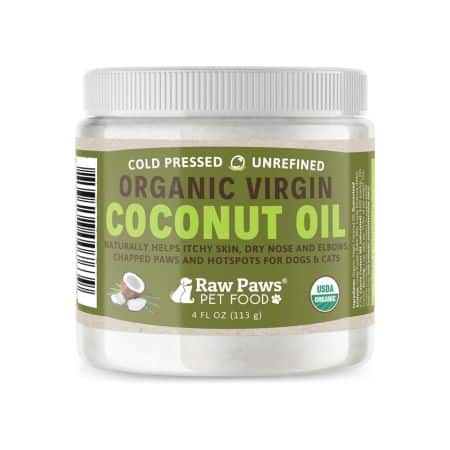
Most dogs love the taste of coconut oil; I know both my dogs do. Please don’t give them too much coconut oil, as it can lead to weight gain and diarrhea. Raw Paw’s Organic Coconut Oil is one of my favorite options for oral and topical use for skin problems.
- Why it helps: Acts as a mild laxative and softens stools.
- How to use it: Add 1 teaspoon for medium dogs, once daily.
- Warning: High in fat—overuse can cause diarrhea or weight gain.
Safe Use & Vet Warning:
Use 1/2 to 1 tsp daily for small to medium dogs. Mix into food or serve alone.
- Avoid if: Your dog is overweight, has pancreatitis, or requires a low-fat diet.
- Stop & call your vet if: Loose stools, vomiting, or greasy diarrhea occur.
Note: Coconut oil should be used sparingly and only under vet guidance for chronic use.
12. Olive Oil
Adding a drizzle of olive oil to your dog’s meals can help ease dog constipation. Like coconut oil, it is a natural laxative that lubricates the digestive system, so it’s important not to give your pup too much. Otherwise, you risk doggy diarrhea.
- Why it helps: Lubricates the digestive tract to ease bowel movements.
- How to use it: Drizzle lightly over meals (about ½ teaspoon for small dogs).
- Warning: Too much can cause loose stools or GI upset.
- Tip: Use extra virgin olive oil for the best quality.
Safe Use & Vet Warning:
Add 1/2 to 1 tsp of extra virgin olive oil to meals, no more than once per day.
- Avoid if: Your dog is overweight or has digestive conditions requiring fat restriction.
- Stop & call your vet if: Diarrhea, vomiting, or abdominal discomfort develops.
Note: Olive oil can help in mild cases, but it is not a long-term solution for constipation.
Complications Of Untreated Dog Constipation
Dogs shouldn’t go longer than 48 hours without pooping, and if they do, it can cause further complications. This list isn’t exhaustive, but it includes the most common complications of dog constipation.
- Megacolon. Your dog’s intestines and colon could become enlarged, dilated, and incompetent. Megacolon can lead to the following issues.
- Obstipation. This is a severe form of constipation that can occur when megacolon and constipation are left untreated. It is often associated with a serious, chronic, permanent, or irreversible medical condition.
- Malnutrition. A lack of appetite can cause rapid weight loss and nutrient deficiencies, which can lead to other health problems.
- Rectal Injury. Straining to poop can lead to rectal tears or strains.
- Rectal Prolapse. Too much pressure from straining can lead to the rectal lining protruding from the anus.
- Secondary Health Issues. Constipation in dogs can lead to further health problems, such as urinary tract infections, perineal hernias, and more. It can also make current health conditions worse.
Dog Constipation Severity Chart: Mild, Moderate & Emergency Signs
Not sure whether your dog’s constipation is something you can manage at home or if it requires urgent veterinary attention? Use the chart below to quickly gauge the severity of your dog’s symptoms and decide your next steps.
| Severity | Signs | What to Do |
|---|---|---|
| Mild | Hasn’t pooped in 24–48 hours. Straining or small, dry stools. No signs of pain or vomiting. Eating and drinking normally. | Try pumpkin, hydration, and light exercise. Monitor stool and energy for 1–2 days. |
| Moderate | Over 48 hours without a bowel movement. Noticeable discomfort or restlessness. Reduced appetite or bloating. | Contact your vet for a physical exam. The vet may recommend laxatives, x-rays, or a fecal softener. |
| Severe / Emergency | Vomiting or lethargy. Straining without results (tenesmus). Visible abdominal swelling or distress. Signs of pain (whining, hiding, trembling). | Seek emergency veterinary care immediately. May require enema, manual removal, or surgery |
How Vets Treat Constipation in Dogs
A vet will perform a physical examination, which may include an X-ray to identify potential obstructions. Sometimes, a vet might request laboratory blood and urine analysis to check for systemic problems.
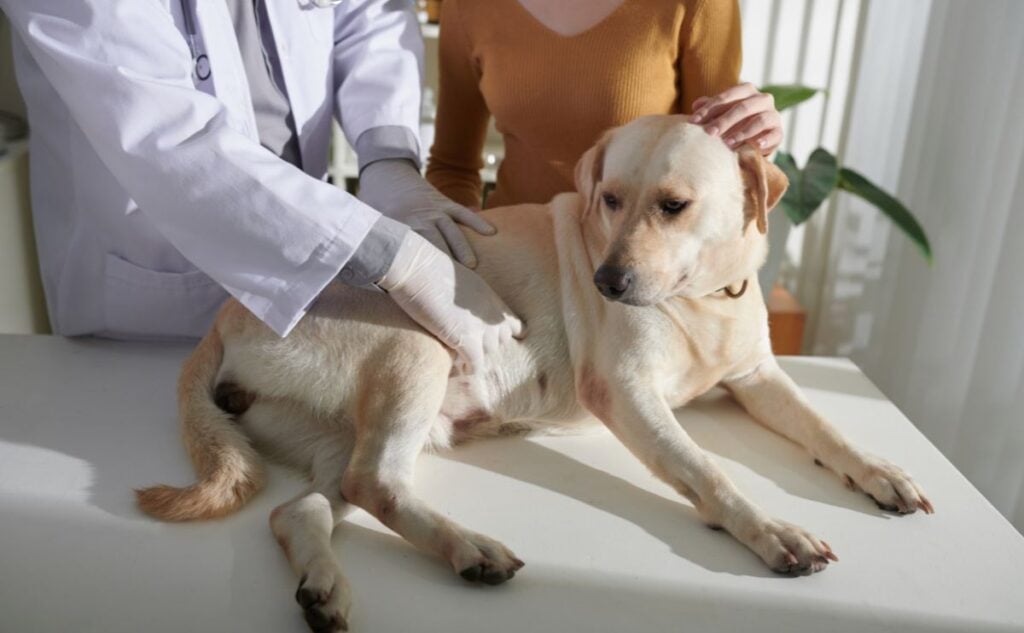
In the meantime, your vet might prescribe a laxative such as lactulose or dioctyl sodium sulfosuccinate, which are clinical-grade laxatives. In severe cases, your dog might need manual removal of the impacted stool, an enema, or gastrointestinal surgery.
How Pet Insurance Can Help
Although constipation is usually treatable at home with natural remedies, sometimes it requires medical intervention. Without it, it can worsen, lead to other health issues, and may be fatal. Having pet insurance can help families manage the financial costs of emergency care.
Constipation in dogs can quickly become a life-threatening emergency. Our pet insurance experts share their pet insurance reviews to help you find the best options for you and your pup. We also provide a free quote widget below to pull prices from our top companies.
What Vets Recommend vs. Risky Internet Myths
There’s a lot of questionable advice online about dog constipation. Here’s what you should know about what works—and what doesn’t—according to veterinary guidance:
| Popular Advice | What Vets Actually Recommend |
|---|---|
| “Just give your dog mineral oil.” | ⚠️ Risk of aspiration pneumonia if swallowed improperly. Only use under direct vet supervision. |
| “Feed your dog raw eggs.” | ❌ Not safe. Raw eggs can carry salmonella and block biotin absorption. |
| “Fast your dog for 24 hours to reset digestion.” | ⚠️ Constipation isn’t diarrhea—fasting can make it worse. Gentle fiber and hydration are safer. |
| “A spoonful of peanut butter will help move things.” | 🚫 Peanut butter is high in fat and can worsen GI issues. Stick with pumpkin or fiber supplements. |
| “Use human laxatives like Dulcolax or Ex-Lax.” | ⚠️ Many human laxatives are toxic to dogs and should never be used without a vet’s guidance. |
Frequently Asked Questions
We know that there are lots of questions about dog constipation and how to help our pups. If your question isn’t listed below, please let us know in the comments, and we’ll get back to you.
Can dog constipation cause vomiting?
Yes, dog constipation can cause vomiting. If left untreated, their colon might become so packed with feces that they aren’t able to empty it on their own. This can lead to vomiting, lethargy, and other serious problems. If your dog is constipated and vomiting, you must take them to the vet.
Are certain dog breeds more prone to constipation than others?
Yes, some dog breeds are more likely to experience constipation than others. Smaller breeds, like my Doxie, have smaller digestive tracts, which can increase the likelihood of constipation. On the other end of the scale, large and giant breeds, like Great Danes, have slower digestive transit times, which can cause firm stools.
Similarly, senior dogs have slower digestive systems, too. If your dog often suffers from constipation, your vet might recommend implementing one of the above home remedies for dog constipation regularly.
Can stress cause constipation?
Yes, stress and anxiety can cause constipation. If you suspect this is causing the issue and your vet gives you the all-clear, consider offering your dog CBD treats or CBD oil. CBD is a natural remedy that lowers a dog’s stress levels and hopefully stops constipation.
Can I treat puppy constipation at home?
Generally speaking, you treat puppy constipation the same way you would treat an adult. However, you need to feed them the appropriate amount for their size, for example, a smaller spoonful of pumpkin puree or yogurt. Some dietary supplements and natural laxatives for dogs are unsuitable for puppies, so it’s important to discuss puppy constipation with your vet first.
Is it safe to use over-the-counter human laxatives for dogs?
Generally, no. Most over-the-counter laxatives made for humans (like Dulcolax, Ex-Lax, or magnesium citrate) can be dangerous or even toxic to dogs. These medications may cause severe dehydration, electrolyte imbalances, or organ issues. Never give your dog a human laxative without your veterinarian’s explicit approval.
How often is “too often” to use pumpkin for constipation?
Plain pumpkin puree can be added to your dog’s meals regularly; many owners use it daily as a fiber supplement. However, moderation is key. For medium dogs, 1–2 tablespoons per meal is usually safe. If your dog needs pumpkin daily to poop normally, this may indicate an underlying health or diet issue. Consult your vet for a more tailored solution.
When is constipation considered chronic instead of occasional?
Occasional constipation may happen once every few months and usually resolves with hydration, exercise, or dietary fiber. Constipation is considered chronic if:
- Your dog regularly skips bowel movements for more than 48 hours
- Straining or hard stools are frequent (more than once or twice a month)
- Your dog requires ongoing remedies (like pumpkin or supplements) just to stay regular
- Your vet has ruled out obstructions, yet symptoms persist
If any of these apply, your dog may need a more in-depth GI evaluation, dietary changes, or long-term support.
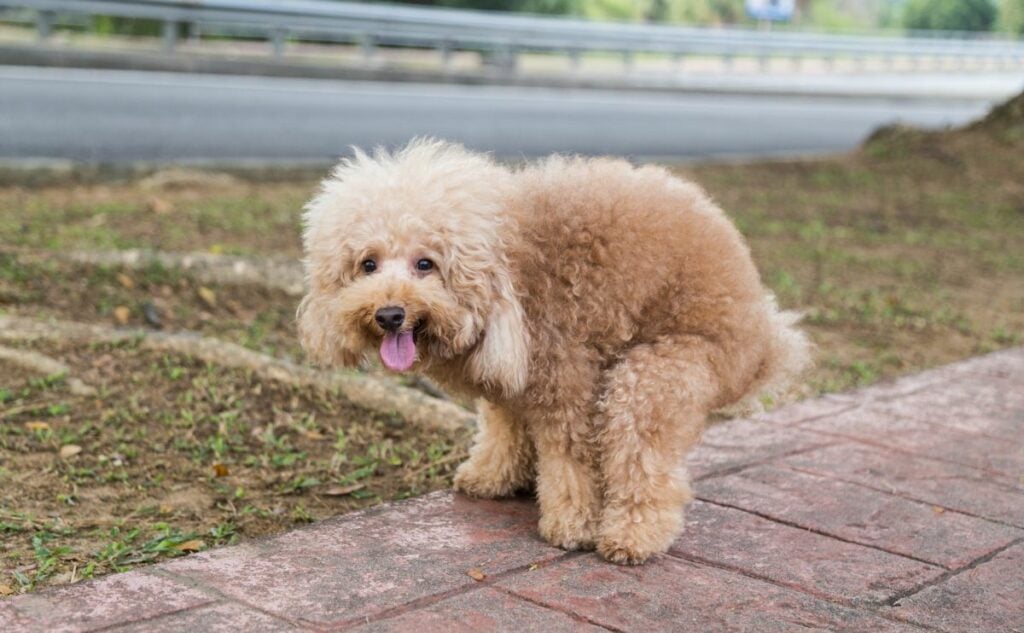
Should You Change Your Dog’s Diet?
If your dog has regular digestive issues, it might be wise to discuss changing your dog’s diet with your vet. We have reviewed our favorite dog food delivery services, some of which you can tailor to your dog’s dietary needs. We have also reviewed several fresh dog food options to help with better hydration. Whatever diet you change to, it’s vital to pick a high-quality, balanced diet and gradually switch to avoid further digestive issues.
While home remedies for dog constipation can work naturally and safely in mild cases, some situations need professional care. Trust your instincts, and don’t wait too long. Your dog’s comfort (and health) depends on it.
Join the Conversation: How Do You Help Your Constipated Dog?
Does your dog regularly suffer from constipation? Perhaps you think I should include another natural remedy for dog constipation in my list? We would love to hear from our readers, so please get in touch with us in the comments section below.

